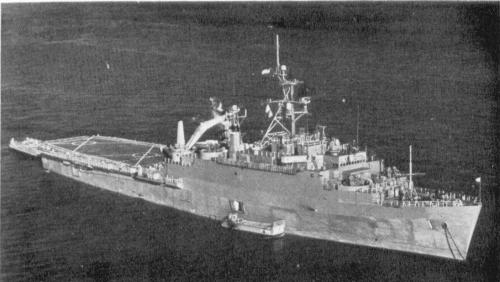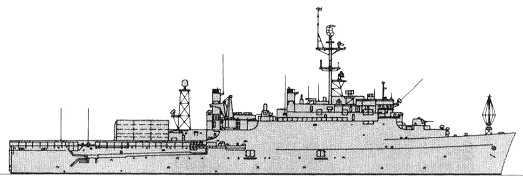
NAVYPEDIA
 Support the project with paypal
Support the project with paypal
Photo

Raleigh 1976
Ships
| No | Name | Yard No | Builder | Laid down | Launched | Comm | Fate |
|---|---|---|---|---|---|---|---|
| LPD1 | Raleigh | New York N Yd, Brooklyn | 23.6.1960 | 17.3.1962 | 8.9.1962 | stricken 1.1992 | |
| LPD2 | Vancouver | New York N Yd, Brooklyn | 19.11.1960 | 15.9.1962 | 11.5.1963 | stricken 4.1997 | |
| LPD3, 7.1972- AGF3 | La Salle | New York N Yd, Brooklyn | 2.4.1962 | 3.8.1963 | 22.2.1964 | flagship 7.1972, stricken 5.2005 |
Technical data
| Displacement standard, t | 8051 |
|---|---|
| Displacement full, t | 13745 |
| Length, m | 152.4 wl 156.4 oa |
| Breadth, m | 25.6 |
| Draught, m | 6.30 |
| No of shafts | 2 |
| Machinery | 2 sets De Laval geared steam turbines, 2 Babcock & Wilcox boilers |
| Power, h. p. | 24000 |
| Max speed, kts | 21 |
| Fuel, t | oil |
| Endurance, nm(kts) |
|
| Armament | 4 x 2 - 76/50 Mk 33, helicopter deck |
| Military load | 932 troops, (1 LCU + 3 LCM(6)) or 4 LCM(8) or 20 LVT, 2 LCM(6) or 4 LCPL |
| Electronic equipment | SPS-10, SPS-40, 2x Mk 34 radars |
| Complement | 501 |
Standard scale images

Raleigh 1990

Raleigh 1979

La Salle 2000

Raleigh 1962
Graphics
Project history
These ships were intended as successors to die Landing Ship Dock with much increased troop (930, 840 in flagships) and cargo (about 2500t) capacity and a smaller well deck (51.2x15.2m), accommodating one LCU and three LCM-6 or four LCM-8 or twenty LVT; in addition there was a large crane at the after end of the superstructure which can launch craft carried on the flight deck, typically two LCM-6 or four LCPL. The Raleighs had no helicopter hangar or maintenance facilities, but ships after the Austin (LPD 4) have a hangar 17.7-19.5m in length and 5.6-7.3m in width, extensible to about 24.5m. The deck has two helicopter spots, but ships have deployed with up to six CH-46 embarked.
The two classes differ in that the Austins were somewhat enlarged. La Salle (LPD3) was reclassified as a flagship (AGF3) for the Middle East Force, undergoing conversion during 1972. She received a small helicopter hangar and covered assembly area on her flight deck, as well as a lattice mast for a satellite communications antenna, and admiral's accommodation, plus additional air conditioning. She was painted white to help reduce heating m the Indian Ocean. The LPD Coronado served as Middle East Flagship (AGF11 vice LPD11) while La Salle underwent a major refit from 1980 to 1982.
LPD7-13 were fitted as amphibious squadron flagships and had an extra bridge level. A proposed LPD16, to have been built under the FY66 programme, was deferred in favour of the LHA programme then cancelled in 1969. The other LPDs were built under the FY59 (prototype), FY60 (1), FY61 (1), FY62 (3), FY63 (4), FY64 (3) and FY65 (2) programmes.
Modernizations
1972, La Salle: + hangar (1 small helicopter like UH-1) and other changes while rebuilt as AGF
1977-1978, all: - 1 x 2 - 76/50, 2x Mk 34 radars
early 1980s, all: + SLQ-32(v)1 ECM suite, 4x SRBOC Mk 36 decoy RL
late 1980s, Raleigh, La Salle: - 3 x 2 - 76/50; + 2 x 6 - 20/76 Mk 15 Phalanx, 2x Mk 90 radars
late 1980s, Vancouver: - 1 x 2 - 76/50; + 2 x 6 - 20/76 Mk 15 Phalanx, 2x Mk 90 radars
1990s, La Salle: + 2 x 1 - 25/75 Mk 38 Bushmaster, 2 x 1 - 12.7/90, SPS-64 radar, SLQ-25 torpedo decoy
Naval service
No significant events.
 HOME
HOME FIGHTING SHIPS OF THE WORLD
FIGHTING SHIPS OF THE WORLD UNITED STATES OF AMERICA
UNITED STATES OF AMERICA AMPHIBIOUS SHIPS AND CRAFT
AMPHIBIOUS SHIPS AND CRAFT RALEIGH amphibious transport-docks (1962 - 1964)
RALEIGH amphibious transport-docks (1962 - 1964)
